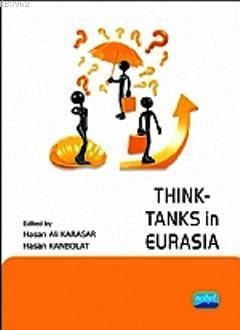9786051334547
556261

https://www.turkishbooks.com/books/think-tanks-in-eurasia-p556261.html
Think-Tanks in Eurasia
6.48
The culture of strategic thinking in Eurasia has very deep roots in history -under the influence of Chinese, Indian, Persian, Mesopotamian, Anatolian, Ancient Greek, Mongolian, Turkish and Russian civilizations.
Their common characteristic seems to be the existence of an imperial past. Another common pattern in all of them is that the strategic thinking in these civilizations had evolved with the motives of ruling different cultures and survival of the state.
In designing the book, we have tried to have a balanced representation of the gigantic Eurasian geography with significant thematic frames.
To this end, we have included articles about the think-tanks and detailed analyses about the strategic thinking cultures of Eurasian countries like Serbia, Armenia, Georgia, Ukraine, Turkey, Russia, Islamic Republic of Iran, Bulgaria, Azerbaijan, Turkestan (Central Asia: Turkmenistan, Uzbekistan, Kazakhstan, Kyrgyzstan, Tajikistan) and Belarus. As to the thematic frames, topics like development of civil society, cultural parameters, the question of the categorization of think-tanks, specialization and experts, think-tanks which are giving birth to others, strategic management procedures in the public sphere, the roles played by the think-tanks at the regional and global communications networks, security sector think-tanks, the roles played by the think-tanks during the colored revolutions, the influences of think-tanks operating in economics sector over the decision making mechanisms, think-tanks in transition to democracy and civil society strategies were included.
Their common characteristic seems to be the existence of an imperial past. Another common pattern in all of them is that the strategic thinking in these civilizations had evolved with the motives of ruling different cultures and survival of the state.
In designing the book, we have tried to have a balanced representation of the gigantic Eurasian geography with significant thematic frames.
To this end, we have included articles about the think-tanks and detailed analyses about the strategic thinking cultures of Eurasian countries like Serbia, Armenia, Georgia, Ukraine, Turkey, Russia, Islamic Republic of Iran, Bulgaria, Azerbaijan, Turkestan (Central Asia: Turkmenistan, Uzbekistan, Kazakhstan, Kyrgyzstan, Tajikistan) and Belarus. As to the thematic frames, topics like development of civil society, cultural parameters, the question of the categorization of think-tanks, specialization and experts, think-tanks which are giving birth to others, strategic management procedures in the public sphere, the roles played by the think-tanks at the regional and global communications networks, security sector think-tanks, the roles played by the think-tanks during the colored revolutions, the influences of think-tanks operating in economics sector over the decision making mechanisms, think-tanks in transition to democracy and civil society strategies were included.
The culture of strategic thinking in Eurasia has very deep roots in history -under the influence of Chinese, Indian, Persian, Mesopotamian, Anatolian, Ancient Greek, Mongolian, Turkish and Russian civilizations.
Their common characteristic seems to be the existence of an imperial past. Another common pattern in all of them is that the strategic thinking in these civilizations had evolved with the motives of ruling different cultures and survival of the state.
In designing the book, we have tried to have a balanced representation of the gigantic Eurasian geography with significant thematic frames.
To this end, we have included articles about the think-tanks and detailed analyses about the strategic thinking cultures of Eurasian countries like Serbia, Armenia, Georgia, Ukraine, Turkey, Russia, Islamic Republic of Iran, Bulgaria, Azerbaijan, Turkestan (Central Asia: Turkmenistan, Uzbekistan, Kazakhstan, Kyrgyzstan, Tajikistan) and Belarus. As to the thematic frames, topics like development of civil society, cultural parameters, the question of the categorization of think-tanks, specialization and experts, think-tanks which are giving birth to others, strategic management procedures in the public sphere, the roles played by the think-tanks at the regional and global communications networks, security sector think-tanks, the roles played by the think-tanks during the colored revolutions, the influences of think-tanks operating in economics sector over the decision making mechanisms, think-tanks in transition to democracy and civil society strategies were included.
Their common characteristic seems to be the existence of an imperial past. Another common pattern in all of them is that the strategic thinking in these civilizations had evolved with the motives of ruling different cultures and survival of the state.
In designing the book, we have tried to have a balanced representation of the gigantic Eurasian geography with significant thematic frames.
To this end, we have included articles about the think-tanks and detailed analyses about the strategic thinking cultures of Eurasian countries like Serbia, Armenia, Georgia, Ukraine, Turkey, Russia, Islamic Republic of Iran, Bulgaria, Azerbaijan, Turkestan (Central Asia: Turkmenistan, Uzbekistan, Kazakhstan, Kyrgyzstan, Tajikistan) and Belarus. As to the thematic frames, topics like development of civil society, cultural parameters, the question of the categorization of think-tanks, specialization and experts, think-tanks which are giving birth to others, strategic management procedures in the public sphere, the roles played by the think-tanks at the regional and global communications networks, security sector think-tanks, the roles played by the think-tanks during the colored revolutions, the influences of think-tanks operating in economics sector over the decision making mechanisms, think-tanks in transition to democracy and civil society strategies were included.
Yorumlar (0)
Yorum yaz
Bu kitabı henüz kimse eleştirmemiş.











